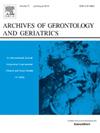50岁及以上妇女身体活动轨迹与认知功能之间的关系:来自中国健康与退休纵向研究的全国代表性队列研究
IF 3.8
3区 医学
Q2 GERIATRICS & GERONTOLOGY
引用次数: 0
摘要
目的探讨50岁及以上女性身体活动轨迹变化与认知功能的纵向关系。方法数据来自中国健康与退休纵向研究,收集于2011年至2020年,涉及2760名50岁及以上的女性。采用基于组的运动轨迹模型,确定了4个运动轨迹组:低波动组、中等增加组、中等稳定组和高波动组。认知功能评估基于情景记忆和精神完整性。采用线性混合效应模型来检验身体活动轨迹与认知功能之间的关系,包括相互作用效应和年龄分层分析。结果中度增高组整体认知功能(β = 0.45, 95% CI: 0.05-0.85)和情景记忆(β = 0.21, 95% CI: 0.05-0.37)水平较高,尤其是50-59岁的女性。相比之下,高波动组和低波动组在认知结果上呈现下降趋势。年龄分层分析显示,在60岁及以上的女性中,中度增高组与认知功能的相关性不显著。结论在50 ~ 59岁女性中,中度增高组整体认知功能和情景记忆较好;然而,这种关联在年龄较大的人群中减弱或未观察到。本文章由计算机程序翻译,如有差异,请以英文原文为准。
Associations between physical activity trajectories and cognitive function in women 50 years and older: A nationally representative cohort study from the China Health and Retirement Longitudinal Study
Objective
To examine the longitudinal association between physical activity trajectory changes and cognitive function in women aged 50 years and older.
Methods
Data were obtained from the China Health and Retirement Longitudinal Study, collected between 2011 and 2020, involving 2,760 women aged 50 years and older. Group-based trajectory modeling was used to identify four physical activity trajectory groups: Low-Fluctuation Group, Moderate-Increasing Group, Moderate-Stability Group, and High-Fluctuation Group. Cognitive function was assessed based on episodic memory and mental intactness. Linear mixed-effects models were employed to examine the association between physical activity trajectories and cognitive function, including interaction effects and age-stratified analyses.
Results
The Moderate-Increasing group was significantly associated with higher levels of global cognitive function (β = 0.45, 95% CI: 0.05–0.85) and episodic memory (β = 0.21, 95% CI: 0.05–0.37), particularly among women aged 50–59 years. In contrast, High-Fluctuation and Low-Fluctuation groups exhibited declining trends across cognitive outcomes. Age-stratified analysis suggested that the association between Moderate-Increasing group and cognitive function was not significant among women aged 60 years and older.
Conclusion
In women aged 50–59 years, the Moderate-Increasing group was significantly associated with better global cognitive function and episodic memory; however, this association was attenuated or not observed in older age groups.
求助全文
通过发布文献求助,成功后即可免费获取论文全文。
去求助
来源期刊
CiteScore
7.30
自引率
5.00%
发文量
198
审稿时长
16 days
期刊介绍:
Archives of Gerontology and Geriatrics provides a medium for the publication of papers from the fields of experimental gerontology and clinical and social geriatrics. The principal aim of the journal is to facilitate the exchange of information between specialists in these three fields of gerontological research. Experimental papers dealing with the basic mechanisms of aging at molecular, cellular, tissue or organ levels will be published.
Clinical papers will be accepted if they provide sufficiently new information or are of fundamental importance for the knowledge of human aging. Purely descriptive clinical papers will be accepted only if the results permit further interpretation. Papers dealing with anti-aging pharmacological preparations in humans are welcome. Papers on the social aspects of geriatrics will be accepted if they are of general interest regarding the epidemiology of aging and the efficiency and working methods of the social organizations for the health care of the elderly.

 求助内容:
求助内容: 应助结果提醒方式:
应助结果提醒方式:


